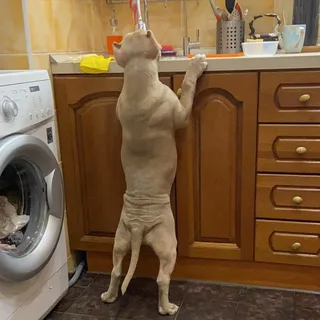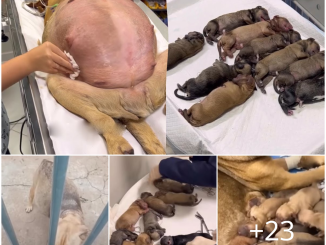Dogs’ brains are sensitive to the familiar high-pitched “cute” voice tone that adult humans, especially women, use to talk to babies, according to a new study.
The research, published recently in the journal Communications Biology, found “exciting similarities” between infant and dog brains during the processing of speech with such a high-pitched tone feature.
Humans tend to speak with a specific speech style characterised by exaggerated prosody, or patterns of stress and intonation in a language, when communicating with individuals having limited language competence.
Such speech has previously been found to be very important for the healthy cognitive, social and language development of children, who are also tuned to such a high-pitched voice.
But researchers, including those from the Eötvös Loránd University in Hungary, hoped to assess whether dog brains are also sensitive to this way of communication.
In the study, conscious family dogs were made to listen to dog, infant and adult-directed speech recorded from 12 women and men in real-life interactions.
As the dogs listened, their brain activities were measured using a functional magnetic resonance imaging (fMRI) scan.
The study found the sound-processing regions of the dogs’ brains responded more to dog- and infant-directed than adult-directed speech.
This marked the first neurological evidence that dog brains are tuned to speech directed specifically at them.
“Studying how dog brains process dog-directed speech is exciting, because it can help us understand how exaggerated prosody contributes to efficient speech processing in a nonhuman species skilled at relying on different speech cues,” explained Anna Gergely, co-first author of the study.
Scientists also found dog- and infant-directed speech sensitivity of dog brains was more pronounced when the speakers were women, and was affected by voice pitch and its variation.
These findings suggest the way we speak to dogs matters, and that their brain is specifically sensitive to the higher-pitched voice tone typical to the female voice.
“Remarkably, the voice tone patterns characterizing women’s dog-directed speech are not typically used in dog-dog communication – our results may thus serve evidence for a neural preference that dogs developed during their domestication,” said Anna Gábor, co-first author of the study.
“Dog brains’ increased sensitivity to dog-directed speech spoken by women specifically may be due to the fact that women more often speak to dogs with exaggerated prosody than men,” Dr Gabor said.

The online community admires a series of moments believed to capture a loyal dog assisting a 95-year-old woman with her daily household chores

woman who has seen almost a century of life’s ups and downs, found herself fortunate to have Max by her side. Despite his lack of formal training, Max’s intuitive understanding of Mrs. Johnson’s needs and his determination to be of assistance have been nothing short of extraordinary. Their heartwarming partnership serves as a beautiful example of the profound connection that can exist between humans and animals.

Max’s assistance in daily household chores has been nothing short of remarkable. With a sense of duty and an eagerness to help, he has become Mrs. Johnson’s dependable companion in her daily routine. Whether it’s retrieving items that are out of her reach, carrying groceries, or even helping with laundry, Max’s willingness to lend a paw has made a world of difference in Mrs. Johnson’s life.

The beauty of their relationship lies not only in Max’s helpfulness but also in the genuine joy they bring to each other. Mrs. Johnson’s face lights up with a radiant smile whenever Max approaches, wagging his tail and ready to take on any task she may need assistance with. Their daily interactions are filled with laughter, gratitude, and an unspoken understanding that goes beyond words.
When a neighbor happened to capture a video of Max’s remarkable assistance and shared it on social media, the internet community couldn’t help but be moved. The clip quickly went viral, garnering thousands of likes, shares, and comments expressing admiration and awe for Max’s loyalty and Mrs. Johnson’s resilience. People from all walks of life, inspired by their story, began to share their own anecdotes of the incredible bonds they have formed with their furry friends.
In conclusion, the heartwarming tale of Max, the faithful dog, and Mrs. Johnson, the resilient 95-year-old woman, has captivated the online community with its message of unwavering loyalty and the power of compassion. Their extraordinary bond and Max’s incredible assistance with household chores have become a source of inspiration, reminding us all of the profound impact animals can have on our lives. Their story serves as a beautiful testament to the enduring strength of the human-animal bond and the limitless capacity for love and support that exists within us all.

Max’s assistance in daily household chores has been nothing short of remarkable. With a sense of duty and an eagerness to help, he has become Mrs. Johnson’s dependable companion in her daily routine. Whether it’s retrieving items that are out of her reach, carrying groceries, or even helping with laundry, Max’s willingness to lend a paw has made a world of difference in Mrs. Johnson’s life.

The beauty of their relationship lies not only in Max’s helpfulness but also in the genuine joy they bring to each other. Mrs. Johnson’s face lights up with a radiant smile whenever Max approaches, wagging his tail and ready to take on any task she may need assistance with. Their daily interactions are filled with laughter, gratitude, and an unspoken understanding that goes beyond words.



Leave a Reply